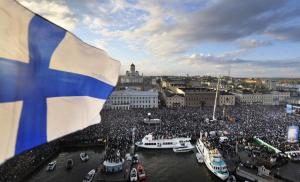Polotsk land in the 12th-13th centuries. Principality of Polotsk - Russian Historical Library
And it arose on the way "from the Varangians to the Greeks." It was this path that contributed to the rapid rise of the principality, its strong economy and well-known culture. The desire for independence, the struggle against the princes of Kyiv, and then the Lithuanians who replaced them - this is the history of the Polotsk principality. Briefly, it looks like this: the more Kyiv put pressure on the Polotsk nobility, the more powerful became the resistance and desire of Polotsk for independence. However, the wars with Kyiv weakened the principality, and in 1307 Polotsk became part of the Grand Duchy of Lithuania.
Formation and dissociation of the principality
Polotsk is mentioned in Russian chronicles in 862. In the middle of the 10th century, Polotsk had its own lord - Rogvolod of Polotsk, whom, at the end of the 10th century, he kills, and takes his daughter as his wife. That allows you to attach this land to the Novgorod possessions. In 987, Prince Vladimir appointed the heir of Izyaslav as the prince of Polotsk, and the city of Izyaslavl became the capital.
As an adult, Prince Izyaslav rebuilt Polotsk, moving the capital of the principality to the left bank of the Polota River, to the most impregnable and high place. Under him, the isolation of the principality from the dominion of Kyiv was started. It should be noted that at the beginning of the XI century, the Polotsk land occupied a vast territory of North-Western Russia. The location of Polotsk at the intersection of the waterways of the Western Dvina and the Upper Dnieper gave great benefits to the principality. Not a small role in the independence of the principality was played by iron-working production.
The reign of Vseslav the Enchanter (1044 - 1101)
The principality acquired the greatest prosperity under the grandson of Izyaslav - Vseslav Bryachislavovich. After a campaign against Torkov, in 1060, Vseslav began a long struggle with Kyiv for possession of North-Western Russia. In 1065, the prince made an unsuccessful attack on Pskov. The failure did not break the prince, and the next year he attacked Novgorod and plundered the city. However, then luck turned away from Vseslav and in February 1067 the Kyiv princes Yaroslavovichi attacked Polotsk principality, capturing Minsk.
On March 3, a significant battle took place near the Nemiga River. For several days, the opponents did not dare to start a battle, not yielding to each other in stubbornness and not making compromises, and on the seventh day, Vseslav Polotsky decided to drive the Yaroslavovichs out of their native land. This battle was described in the Tale of Igor's Campaign, as well as in the Kyiv chronicles. The prince himself escaped captivity and fled to Polotsk. According to legend, the prince was a werewolf sorcerer and fled the battlefield in the form of a wolf.
In the summer of the same year, the Yaroslavovichs invited the prince to Kyiv for peace negotiations, promising him safety before the cross. However, Kyiv did not keep his word, and Vseslav was captured. In 1068, the Yaroslavoviches had to defend their native land against the Polovtsy. However, they lost the battle on the Alta River and fled. Kyiv was left without protection. On September 15, 1068, the Kiev uprising took place, and the people of Kiev freed Vseslav by force, appointing him the Grand Duke. The Yaroslavoviches naturally did not like this turn of affairs, and they fled to Poland for help.
When Vseslav heard that the Yaroslavovich army was heading for Kyiv, he abandoned the city and fled to his native land - Polotsk. Like, houses and walls help, but he needs Kyiv, like a second tail to a wolf. This did not help him much, and Izyaslav captured Polotsk, placing his son to reign there. In 1072, Vseslav regained Polotsk, after which the rapprochement between Izyaslav and Vseslav began. With the rest of the Yaroslavovichi, he fought uncompromisingly.
Accession of Polotsk to ON
Having many sons in the family, Vseslav Charodey divided Polotsk land into 6 destinies, which were further divided more and more. In 1127, Kyiv captured the Polotsk lands, devastated them and sent the Polotsk princes to Byzantium. However, three years later, power fell to one of the Polotsk princes, and after his death, a struggle for the throne began between three dynasties by a descendant of Vseslav, which finally undermined the combat capability of Polotsk, and in 1216 the Livonian Order captured the lands in the lower reaches of the Western Dvina.
A century later, the principality submitted to the Grand Duchy of Lithuania (GDL). The principality finally ceased to exist after 76 years, when Lithuania abolished the autonomy of Polotsk.
Ministry of Education of the Republic of Belarus
educational institution
"Belorussian State University transport"
Department: philosophy of history and political science
Self-guided student work
Polotsk and Turov principalities
Fulfilled
mechanical student
Group MV-11 Struk A.V.
Checked
Senior Lecturer
Ryabtseva N.A.
Gomel 2014
Turov Principality
Christianity and Enlightenment
Bibliography
Polotsk Principality of Turov Christianity
1. Political structure of the Principality of Polotsk: authorities and administration
The first chronicle information about Polotsk dates back to 862. Under this date, in the "Tale of Bygone Years" there is information that the Scandinavian prince Rurik, the Novgorod prince, began to distribute cities to "his husbands" along with other cities, Polotsk is also mentioned. The name of this prince was not preserved in the Tale, but it can be assumed that he, like Rurik, was a Varangian.
The fact that Polotsk fell under the influence of Rurik, who sought to subjugate the northern part of the route "from the Varangians to the Greeks", could not but cause opposition from Kyiv. The Kyiv princes Askold and Dir in 865 (according to some sources in 867) carried out a campaign against the Krivichi. The Ipatiev Chronicle does not provide information about the consequences of the campaign, but notes that the Kyiv princes "fought the Polotsk people, and did a lot of trouble to them."
At the end of the ninth century Polotsk was conquered by Prince Oleg and annexed to Kievan Rus. This is evidenced by the mention in the annals of the campaign of Prince Oleg of Kyiv to Smolensk, after which a tribute was established for the Krivichi. The significant influence of Kyiv on the development of the Polotsk principality of that time is also confirmed by chronicle information about Oleg's campaign against Tsargrad in 907, in which the Polotsk people also took part. This is evidenced by the list of cities that received the reward. Polotsk, in addition to the prescribed 12 hryvnias, each participant in the campaign also received an additional reward due to the fact that Oleg's vassal was the prince in it.
There was no mention of the withdrawal of the Polotsk principality from the power of Kyiv as a military-political event, but the fact that this happened in one way or another from 907 to 947 is confirmed by the following: in 947, Princess Olga begins on lands dependent on Kyiv, to establish a regulated amount of tribute. Among the lands for which new tribute values were established, there is no Polotsk, therefore, she did not pay tribute to Kyiv.
By 980, one can definitely talk about the independence of Polotsk from both Kyiv and Novgorod. At this time, Prince Rogvolod reigns, about whom Tatishchev's "History of Russia" says: "Rogvolod was from the princes who came from the Varangians." In the historical literature there is no single approach to the ethnicity of Rogvolod: whether he was a Slav or a Varangian, but the main thing is that it was under him that Polotsk turned into a strong independent state. The definition given by the chroniclers to the first prince of Polotsk Rogvolod: "He held, owned and reigned the land of Polotsk" - testifies to the completion of the first stage of the formation of the state. Borders were defined, the political system and internal economic relations were established. The process of creating statehood during the time of Rogvolod coincided with similar processes among other European nations: Czechs, Moravians, Croats, Slovenes, Poles, as well as with the creation of the first centralized states in Scandinavia - Denmark, Sweden and Norway.
Principality of Polotsk under Vseslav Brachislavovich
By the middle of the XI century. large internal resources accumulated inside the Polotsk state, making it possible further development, protection and upholding of their interests, independence. All this was very clearly manifested in the second half of the 11th - early 12th centuries. during the life and work of Polotsk prince Vseslav Brachislavich. The Tale of Bygone Years reports: "In the same year, Brachislav, the son of Izyaslav, the grandson of Vladimirov, the father of Vseslav, died, and Vseslav, his son, sat on the princely table in Polotsk"
The activity of this prince has always caused an ambiguous assessment of both contemporaries and historians. He was born around 1029. Already the very birth of the prince was shrouded in mystery and legends. According to the chronicle, the mother gave birth to him "from sorcery", and at birth the baby had a kind of "ulcer" on the head. The Magi (servants of the pagan cult in Polotsk) advised his mother to tie this "ulcer" around his neck in the form of an amulet, so that he would wear it until his death. Which is what was done. "For this sake, he was merciless to bloodshed," the unknown chronicler summed up. From the moment the prince came to the Polotsk throne in 1044 after the death of his father and until 1060, he did not show himself in any way in the Eastern European space. Vseslav maintained peaceful relations with Yaroslav the Wise, who maintained stability in the Kyiv lands, suppressing civil strife. After his death in 1054, his father's policy of preventing civil strife, his son Izyaslav, in alliance with the brothers Vsevolod and Svyatoslav. It can be assumed that until the 60s of the XI century. Vseslav strengthened the state he inherited. Of the 35 cities that existed on the territory of Belarus at that time, the Polotsk land belonged to the largest: Vitebsk, Zaslavl, Drutsk, Braslav, Minsk, Orsha, Logoisk. The cities themselves are growing. Actually, Polotsk occupies at that time an area of more than 20 hectares with a population of about 10-15 thousand people. It was at this time that the first and largest Christian cathedral was being built in the city - in honor of Hagia Sophia - the Wisdom of God, similar to Constantinople, Ohrid and as opposed to Kyiv and Novgorod Sophia.
The confirmation of Vseslav's alliance with the South Russian princes is the campaign of 1060, when the South Russian princes-brothers Yaroslavichi invite Vseslav of Polotsk to take part in a joint campaign against the nomads - Torks. The campaign was successful, because, as the chronicler reports, the Torques fled as soon as they saw the huge united army of the Slavic princes.
The alliance was broken by Vseslav himself, by an attack in 1065 on Pskov and in 1066 on Novgorod. The main reason, according to the researchers, was the clash of the economic interests of these cities with the interests of the Polotsk principality.
For the attack on Pskov, Vseslav chose a convenient moment. At this time, Izyaslav, Svyatoslav and Vsevolod were involved in a war for power in Tmutarakan. The siege of Pskov did not bring results. Despite the fact that the Polotsk prince for the first time in the history of East Slavic military affairs used wall-beating machines - "vices" during the siege of the city. The walls of Pskov did not give in, and the Polotsk people were forced to retreat to Polotsk.
In 1097, on the initiative of the grandson Yaroslav Pereyaslav prince Vladimir Vsevolodovich Monomakh (after maternal line Vladimir was the grandson of the Byzantine emperor Constantine Monomakh) a congress of princes gathered in the city of Lyubech. The princes appreciated the disastrous consequences of strife and, in order to avoid them, established a new principle of organizing power: "everyone keeps his fatherland." The possessions of each princely family became her hereditary property. This decision consolidated feudal fragmentation.
Prince Vseslav of Polotsk did not participate in the congress of princes in Lyubech. This is due to the fact that he was an independent ruler in his lands. The princes of Polotsk were overlords of the territory where their power was exercised, as well as in other medieval states. The formation between the possessions of the Polotsk prince as the overlord of the country takes place in the X-XI centuries.
But Vseslav Brachislavovich was the last prince who owned the entire Polotsk land. After his death, destinies-regions began to stand out from the composition of the Polotsk land, in which representatives of the Polotsk princely dynasty had the right to reign. After the death of Vseslav, the Principality of Polotsk was divided into destinies between his sons.
The process of decentralization of the Principality of Polotsk began as early as the end of the 11th century, when, along with the regions subordinate to Polotsk, there were already regions, appanages, which were led by the eldest sons of Vseslav. The "History of Russia" mentions 7 names of "Vseslavichs": Davyd, Gleb, Rogvolod, Boris, Roman, Rostislav, Svyatoslav. In historical sources there is no confirmation of the information that each of them received his inheritance, but according to the "History of the Russian" it can be concluded that the sons of Vseslav were entrenched in all areas of the Polotsk principality.
The eldest sons of the illustrious prince were, apparently, Davyd, Boris and Gleb. The Polotsk prince Davyd was overthrown by the Polotsk people in 1128 and Rogvolod was put in his place, but in 1128 the death of not Rogvolod, but Boris was reported. It can be assumed that Rogvolod had a cross name Boris. This is also confirmed by the late Gustyn Chronicle, which, according to sources unknown to us, directly indicates: "Rogvolod or Boris"; Boris was obviously the second son of Vseslav, the third was Gleb.
Public life and economic development Polotsk land
First historical information chronicles about Polotsk date back to 862. Prince Rogvolod "Held, owned and reigned the Polotsk land", which indicates the completion of the first stage of the formation of the state. The boundaries of this land were determined, the political system and internal economic relations were established. The process of creating statehood during the time of Rogvolod coincided with similar processes among the Czechs, Moravians, Croats, Slavs, Poles, as well as with the creation of the first centralized states in Denmark, Sweden and Norway. The cities of the Polotsk land were not only the centers of residence of the princely administration (regional capitals), they also performed sacral, defensive, trade and craft functions. In the XII-XIII centuries. monks-chroniclers were aware of the existence of 36 cities on the territory of modern Belarus.
In the "Tale of Bygone Years" the term "Polotskians" is found simultaneously with the endoethnonym of the inhabitants of Polochchina - "Krivichi". Thus, the chronicle states the tribal territorial self-determination of a part of the Krivichi (in contrast to the Pskov-Izborsk and Smolensk) based on the creation of a separate principality with its capital in Polotsk. Most modern researchers agree that the name "Polotskans" "is territorial" and not ethnic.
The economic basis of the Polotsk land, in addition to traditional agriculture, was craft, trade and the favorable geopolitical position of the principality. The central place in the trade relations of Polotsk with Europe, Byzantium, the countries of the Arab East, Persia was assigned to the famous route "from the Varangians to the Greeks". One of the largest branches of this route passed along the Dvina through Polotsk.
The ideological foundation of the state at the initial stage was paganism, close to both the Slavs and the Balts, and since 988 - Christianity, but with a tolerant attitude towards the old traditions. Main question foreign policy Polotsk land was a struggle for geopolitical leadership and the use of benefits from trans-European trade routes. This led to military-political conflicts between Polotsk and Novgorod and Kyiv. In the 12th century, despite the actual fragmentation of the Polotsk land, it was still often considered as an integral state. At the same time, great changes began in the socio-political life of the Polotsk land. Veche became more active - the general meeting of the townspeople, which was also the highest judicial instance. A diversified economy developed. Tribal production and slavery gave way to feudal relations. The tribute was replaced by feudal rent, estates and volosts appeared, the patriarchal way of life collapsed, the first guild organizations were created in the cities. Vassal relations were established between the "senior" and "junior" princes.
In 1201, with the permission of Prince Vladimir of Polotsk, at the mouth of the Dvina, German crusader knights and missionaries founded Riga. This was the beginning of the end of the independence of the Polotsk land. Resisting external aggression, Polotsk was forced to make an alliance with Novgorod and Lithuania. In the late 50s - early 60s. 13th century the first Lithuanian prince Tovtivil appears in the Polotsk reign. Thus began a new period of existence of the Polotsk lands - as part of the Grand Duchy of Lithuania.
Turov Principality
The Turov principality was formed on the territory of southern Belarus in the basin of the Pripyat and its tributaries. The capital of the principality - the city of Turov is mentioned in the annals under 980. Until the end of the 10th century. The Turov principality developed as an independent one. A dynasty of princes ruled here. From the end of the X century. in Turov reigns the son of the Grand Duke of Kyiv Svyatopolk, who fought for the independence of the principality. From 1054 to 1119 the Principality of Turov was owned by Prince Izyaslav (son of Yaroslav the Wise) and his sons. Since 1113, the principality passed to the heirs of V. Monomakh. In the 50s of the XII century. Yuriy Yaroslavovich took possession of the Turov principality, who returned the principality to the dynasty of Prince Izyaslav. A feature of the socio-political system of the Turov principality was the presence in the city of both the prince and the posadnik, which was still characteristic only of Novgorod the Great.
At this time, the inhabitants of Belarus put up stubborn resistance to the Mongols-Tatars, when they, devastating Russia, moved in 1240-1242. to the west. The flank detachments of Batu passed through the southern part of Belarus, devastated and plundered Mozyr, Turov, Pinsk, Brest. In the middle and second half of the XIII century. The Mongol-Tatars more than once carried out raids on the Belarusian and Lithuanian lands, but they failed to conquer and subjugate them. At the end of the XII - beginning of the XIV century. The Turov land was completely annexed to the Grand Duchy of Lithuania. Turov events are very indicative. The events took place around 1013 in Turov. True, for some reason they did not find their reflection in the Kiev chronicle, and information about them came to us from foreign sources, namely from the "Chronicle" of Dietmar, Bishop of Merseburg. We already know that Svyatopolk, one of the sons of Vladimir Svyatoslavich, was appointed prince in Turov, although, according to some sources, he could also be the son of Yaropolk, with whose wife Vladimir married after the victory over the latter. It is believed that Svyatopolk could have been born in 978-980. When he became the prince of Turov, it is not known exactly. Somewhere between 1008-1013. he married the daughter of the Polish king Boleslav. Researchers see in this, on the one hand, Vladimir’s desire to consolidate what he had won from the Poles (in this case, those who attribute this marriage to 992 are right, because then Vladimir conquered the Cherven cities), and on the other hand, Boleslav’s desire with the help son-in-law to strengthen his influence in the east.
According to Ditmar, together with Svyatopolk's wife, her confessor, the Calabragi Bishop Reinberg, also came to Turov, whose task most likely was to promote the penetration and promotion of Boleslav's interests. He allegedly became close to Svyatopolk and, with the knowledge of Boleslav, began to incite the Prince of Turov to adopt Latinism and speak out against his father. But the latter found out about this and put Svyatopolk in prison with his wife and Reinberg. Boleslav, in response to this, was going to go against Vladimir, but because of the discord with the Pechenegs, the campaign stopped, perhaps the reason for this was Vladimir's consent to Boleslav's demand to release Svyatopolk. The old historiography considered these events only in the light of the Kiev-Polish struggle. But we must not forget about the interests of Turov. If Polotsk played a decisive role in the struggle between Kyiv and Novgorod, then Turov occupied the same place in the struggle between Kyiv and Poland. But, just as Polotsk had its own interests and pursued its own policy, using the contradictions of Kyiv and Novgorod, so Turov, despite his dependence on Kyiv, also never forgot about his interests and, in order to satisfy them, could play on the contradictions of Kyiv and Poland and before to influence the political behavior of Svyatopolk. This can be confirmed by the fact that Svyatopolk, and then, as he was taken out of Turov, still remained his prince, and, most importantly, he kept in touch with his fans here. During the struggle with Yaroslav, according to the Suzdal chronicle, he gathered "warriors" in the Turov land ("in Pinsk"). In Ditmar there is a message that Yaroslav, fighting Svyatopolk, occupied a certain city, under which, as some researchers believe, Turov should be seen, which seems to prove that this city supported Svyatopolk. Although all this does not have a solid ground, however, the possibility of such a thing cannot be completely denied either.
Under the conditions of the forcible annexation of certain historical lands under the rule of Kyiv, the sons of the Grand Duke appointed there could easily be imbued with local interests and become their guides. Even Yaroslav, having become the Grand Duke of Kyiv (he severely punished for separatism), sitting in Novgorod, prepared the separation of the latter from Kyiv. What can we say then about Svyatopolk, who was sitting, though in a land close to Kyiv, but very isolated from its natural conditions, which could not help but feel the entire burden of dependence. But no matter how obscure and controversial the events of 1013 may be for us, very important moments of our history first appeared in them: Turov’s desire for isolation from Kyiv, which his subsequent history confirms; this is the first fact of rivalry between Russia and Poland for one of the Belarusian lands recorded by sources.
In the future, it will become one of the unfavorable factors in our history, which is closely connected with the previous one - the beginning of the struggle between Latinism and Orthodoxy for superiority among the Belarusian population. The first mention of the city of Brest (modern Brest) is directly connected with the struggle between Yaroslav and Svyatopolk. The Ipatiev Chronicle reports that in 1019 Svyatopolk, having suffered a defeat in the struggle for the grand duke's office, runs away from the state and stops for a while in Brest. Based on this, the researchers express the opinion that this city was the last point before the "Latsk land" and that it, built on the land, "skalanizavanay" by the Dregovichi, was originally part of the Turov principality. Archaeological materials make it possible to date the pre-continental layers of the ancient settlement at the turn of the 10th-11th centuries. The emergence of a city on a cape at the confluence of Mukhavets with Vost. The Bug was due to its importance as a border fortress and a stronghold of the Slavic development of the surrounding territory. At the same time, it was also of great commercial importance. The border position of Brest led to the fact that the city from the very beginning of its history became the object of aggressive attacks from different sides. So, the first mention of the city of Brest is directly connected with the struggle between Yaroslav and Svyatopolk. The Ipatiev Chronicle reports that in 1019 Svyatopolk, having suffered a defeat in the struggle for the grand duke's office, runs away from the state and stops for a while in Brest. Based on this, the researchers express the opinion that this city was the last point before the "Latsk land" and that it, built on the land, "skalanizavanay" by the Dregovichi, was originally part of the Turov principality. Archaeological materials make it possible to date the pre-continental layers of the ancient settlement at the turn of the 10th-11th centuries. The emergence of a city on a cape at the confluence of Mukhavets with the Eastern Bug was due to its importance as a border fortress and a stronghold of the Slavic development of the surrounding territory. At the same time, it was also of great commercial importance. The border position of Brest led to the fact that the city from the very beginning of its history became the object of aggressive attacks from different sides. So, already in 1022 Yaroslav makes a campaign under this city. The chronicle does not report on the goals or results of this campaign, which gave rise to some researchers for the opinion that Yaroslav did this campaign in order to return Brest, captured in 1020 by Boleslav, and that he achieved this only in 1044.
Christianity and Enlightenment
As you know, in 988, Prince Vladimir of Kyiv proclaimed Christianity the official religion of his state. It was a matter of small things. To convey this idea to all ends of Russia. And there were many ends, and not all of them happily accepted the prince's initiative. Therefore, often had to use violence. As they said in those days, Russia was baptized with "fire and sword."
Christianity came to the lands of modern Belarus in different ways. In Polissya, the patrimony of the Dregovichi, a new religion was brought peacefully. There is a legend about stone crosses that sailed along the Dnieper and Pripyat directly from Kyiv, and stained the waters in the regions of Turov and Pinsk with blood. Struck by such a spectacle, the Poleshchuks accepted the new faith. Those who did not accept were persuaded by military formations from Kyiv.
The process of Christianization went somewhat differently in the lands of the Krivichi. The Krivichi have never been absolutely subordinate to Kyiv. And their capital, Polotsk, tried to pursue an isolated policy. Kyiv did not have enough military forces to resolve the issue by force.
However, in Polotsk they understood that the adoption of Christianity was inevitable. In addition, it brings certain benefits. Development of culture and writing, maintaining relations with neighboring, already Christian countries. Indeed, at that time, all the neighbors of the Krivichi, except for Lithuania, had already been baptized.
The first known Christians of Polotsk were Princess Rogneda (baptized Anastasia) and her son Izyaslav. Izyaslav was a pious man and did a lot for the development of writing and sciences in Polotsk.
In 992, the Polotsk diocese was created on the lands of the Krivichi. Somewhat later, a diocese for the Dregoviches was created in Turov. Radimichi resisted the process of Christianization the longest. In their land, the Principality of Smolensk, the diocese was organized only in the 12th century.
Through the Christian culture Belarus entered the European civilization. Gradually eradicated such remnants of paganism as polygamy, blood feud, pagan sacrifices.
Stone architectural structures began to appear on the lands of Belarus, the most majestic of which, undoubtedly, is the Church of St. Sophia in Polotsk on the Dvina.
Schools were attached to churches and monasteries. Books were written there. Educated monks were advisers to princes in state affairs.
Bibliography
1. The Tale of Bygone Years // Tales of Ancient Russia of the XI-XII centuries;
. #"justify">. #"justify">. V. Ignatovsky Brief essay history of Belarus. Mn. 1991
History of Belarus. Ed. A. Kokhanovsky. Mn. 1997
M. Ermolovich Ancient Belarus: Polotsk and New City periods. Mn. 1990
Kyiv and the western lands of Russia. Digest of articles. Institute of History of the Academy of Sciences of the BSSR, Mn. 1982
Ancient Russian principalities. Digest of articles. Institute of History of the Academy of Sciences of the USSR, Mn. 1975
Tutoring
Need help learning a topic?
Our experts will advise or provide tutoring services on topics of interest to you.
Submit an application indicating the topic right now to find out about the possibility of obtaining a consultation.
The first of the specific principalities, separated from the composition of the ancient Russian state, later gaining independence. In the period from the 14th to the 18th century, it was part of.
The Principality of Polotsk carries its history of existence even before. It is known that as early as the beginning of the 870s, the prince obliged the Polotsk people to pay tribute, and later the prince of Kyiv did the same. In the period from 972 to 980. the Norman Rogvolod reigned on Polotsk land, the principality was considered dependent on the then ruling prince in Kyiv. Polotsk land was listed as part of the ancient Russian state already in 980 after the prince killed Rogvolod, captured Polotsk and married the daughter of the murdered - Rogneda. In 988 - 989 years. Vladimir appointed his son Izyaslav to the throne, who later became the ancestor of the princely dynasty. In 992, the Polotsk diocese was formed.
Despite the fact that the lands of the principality were almost barren, it was located at the intersection of significant trade routes along the Dvina, Neman and Berezina; fortified forests protected from enemy attacks. This contributed to the resettlement of foreign peoples here. Cities developed rapidly, becoming trade and craft centers (Polotsk, Izyaslav, Minsk, etc.). Such prosperity in the economy gave the Izyaslavichs some resources, relying on which they fought with the Kyiv authorities for independence.
From 1001 to 1044 Bryachislav - Izyaslav's heir led an independent policy, trying to expand his possessions, taking advantage of the weakening of Russia due to. In 1021, he managed to capture Veliky Novgorod, but then the prince rebuffed him on the river. Sudome. Yaroslav, out of courtesy to Bryachislav, gave him the Usvyat and Vitebsk volosts.
The peak of the power of the Polotsk principality is considered to be the period of the reign of Vseslav (1044 - 1101), the son of Bryachislav. He began to expand the land to the north and northwest, imposing tribute on the neighboring tribes of the Livs and Latgalians. In 1067, after unsuccessful campaigns on, the prince struck back at Vseslav, capturing Minsk, breaking his squad, and, together with his two sons, captured. The Principality of Polotsk passed into the possession of Izyaslav. On September 14, 1068, the inhabitants of Kyiv who rebelled against Izyaslav overthrew him and Vseslav regained Polotsk. In 1069 - 1072. despite the brutal war with Izyaslav, Mstislav, Svyatopolk and Yaropolk (sons of Izyaslav), Vseslav retained the Principality of Polotsk.
In 1078 he captured the principality of Smolensk and part of the north. However, in 1078 - 1079. the prince attacked the Principality of Polotsk and destroyed some of the cities. In 1084 he captured Minsk and defeated the Polotsk land. Vseslav exhausted all his resources and stopped expanding his possessions. After the death of Vseslav in 1101, the Principality of Polotsk broke up into destinies. In 1119, the aggression of the Izyaslavichs against their neighbors stops after unsuccessful attempts to get Novgorod and the Smolensk principality. The principality is weakening, Kyiv is taking advantage of the moment: in 1119, Vladimir Monomakh seizes the inheritance of Gleb Vseslavich, and throws him into prison; in 1127 he ravaged the Polotsk land in the south-west; in 1129, due to the refusal of the Izyaslavichs from the campaign with the Russians against the Polovtsy, Mstislav seizes the principality and at the Kiev Congress asks for the imprisonment and deportation of the Polotsk princes to Byzantium; Then he gives the Polotsk land to his son Izyaslav, and puts governors in the cities.
In 1132, one of the Izyaslavichs, Vasilko Svyatoslavich, managed to return the Principality of Polotsk, but not its former power and strength. In the 12th century, a fierce struggle for the princely throne flared up between Rogvolod Borisovich and Rostislav Glebovich. In 1150 - 1160. Rogvolod fails in an attempt to reunite the principality due to disagreements with other Izyaslavichs and outside interference (prince, etc.). By the 13th century, German knights were conquering the tributaries of Polotsk; by 1252, Polotsk and other cities were taken by the Lithuanian princes; at the end of the 13th century, in the struggle between the Teutonic Order, Lithuania and the Smolensk princes for the Polotsk lands, Lithuania prevailed.
In 1307, the Lithuanian prince Viten conquered Polotsk from the Swordsmen, and Gedemin, who ruled after, took possession of the Minsk and Vitebsk principalities. By 1385, the Principality of Polotsk became part of the Lithuanian state.
In written sources, early feudal public education Eastern Slavs The Principality of Polotsk is known under the name "land". Its center was the city of Polotsk, which is also mentioned in the Chronicle "The Tale of Bygone Years" under 862. The city was located on the Western Dvina River, which was part of the most important trade route "from the Varangians to the Greeks." Profitable geographical position contributed to the rapid growth of Polotsk and its transformation into a major center of trade and crafts.
The first historically known prince of Polotsk was Rogvolod. In the 60s and 70s. 10th century Polotsk, as a possible ally, was given great importance in the rivalry between Kyiv and Novgorod, which were also on the way "from the Varangians to the Greeks." Rogvolod gave his consent to the marriage of his daughter Rogneda with the stronger Kyiv prince Yaropolk. Prince Vladimir of Novgorod, who also asked for the hand of the daughter of the prince of Polotsk, was refused. The refusal offended Vladimir. Polotsk was taken and burned by his troops. Rogvolod, along with two sons, were killed. Rogneda forcibly became Vladimir's wife. This event took place around 980.
Later, Vladimir killed his brother Yaropolk and became the great prince of Kyiv. This name is associated with the adoption in 988 and the spread of a new religion in the lands of the Eastern Slavs - Christianity. Under Vladimir, the ancient Russian state of the Eastern Slavs reached its peak Kievan Rus, which, according to some historians, included the Polotsk land.
Vladimir gave Rogneda the new name of Gorislav. Perhaps Rogneda, who lived with Vladimir for several years, never forgave him for the death of his father and made an attempt on his life. But the assassination attempt failed, and Rogneda, according to the then laws, had to be killed. The mother was defended with a children's sword in the hands of the young son Izyaslav, who said to Vladimir: “Father! You are not alone here! Vladimir ordered to send Rogneda and his son and Polotsk land. Here a city was built for her, named after her son - Izyaslavl. Rogneda was tonsured (according to another opinion, she was tonsured) as a nun under the name Anastasia. She remained known in history as a princess with three names and one of the first nuns among the Eastern Slavs.
During the life of Rogneda, the inhabitants of Polotsk invited Izyaslav to reign. He is known in history as a scribe-prince who knew and spread writing along with Christianity in Polotsk. Prince Izyaslav died young in 1001, outliving his mother by a year.
The strengthening of the Polotsk principality took place in the 11th century. under the son of Izyaslav, Prince Bryachislav of Polotsk. He and his troops captured the portages that connected the rivers Western Dvina and Dnieper on the way "from the Varangians to the Greeks" and belonged to Novgorod. They allowed using logs to hold ("wire") ships and thus pass from the Baltic (Varangian) to the Black (Russian) Sea. However, the army of Bryachislav was defeated by his uncle, Prince Yaroslav the Wise of Kyiv. He himself wanted to control the path "from the Varangians to the Greeks" and collect tribute from the merchants.
Legends fanned the name of the son of Bryachislav - the Polotsk prince Vseslav, nicknamed the Enchanter. It was as if he was born with the help of witchcraft. The unknown author of The Tale of Igor's Campaign compares Prince Vseslav with a werewolf. For more than 50 years, from 1044 to 1101, the prince ruled the Polotsk land, which reached its peak under him.
Vseslav, expanding his power, sought to seize lands and cities outside the Polotsk principality. Unable to take Pskov, he captured and plundered Novgorod. In response to the actions of Vseslav, the three sons of the Kyiv prince Yaroslav the Wise attacked in 1067 the border town of the Polotsk land of Mensk (now Minsk). The city was burned, and its inhabitants - men - were taken prisoner and sold into slavery.
The method of state administration in the Polotsk land was princely-veche system. The power of the prince was associated with the existence of the vecha - a general meeting of adult men, which could remove and appoint the prince. The name "veche" probably comes from the fact that at the meeting they talked ("broadcast") about important public affairs. The meeting of citizens was called upon by the sound of the veche bell, and the decision was made according to the strength of the cry of those who supported it. The duties of the prince included the organization and command of the army, the collection of tribute from the local population.
The troops and Polotsk consisted of a squad - an armed detachment of people specially trained in military affairs - and a people's militia, consisting of townspeople and called the "regiment".
On the East Slavic lands there were laws called "truths". The most famous among them is the collection "Russian Truth", developed under the great Kiev prince Yaroslav the Wise. The court was carried out by the prince or his representatives. The guilt of the accused was usually determined in favor of the prince through monetary fines or physical punishment. It was believed that the proof of guilt depended on the "judgment of God." For example, if the accused had burns after holding his hand over the fire, then this showed that he was really guilty.
Principality of Polotsk - Principality of the Krivichi on the "Road from the Varangians to the Greeks". The first chronicle information about him is associated with the Scandinavian Vikings. The chronicle "Deeds of the Danes" (Gesta Danorum) tells about the campaign against Polotsk by the legendary King Frodi I (5th-6th centuries AD). In the "chronicles of the Russians" it was first mentioned in 862 ("The Tale of Bygone Years").
A detailed analysis of information about "Polotsk in the time of Attila" can be viewed.
Since the Polotsk chronicles disappeared along with the destroyed St. Sophia Cathedral, today we know about many episodes of history only from the Scandinavian chronicles. So Sophia, the Princess of Minsk - is not mentioned in Russian chronicles, but is well known from Western sources (the works of Saxo Grammar, the Saga of the Knutlings, the genealogy of the Danish kings) - she was the Queen of Denmark, the wife of Valdemar I the Great.
funny facts
- The eastern border of the Principality of Polotsk is the oldest border of Belarus. Today, 1000 years later, it passes through the same places
- During this 1000 years, over 90% of the wars with neighboring states took place on the eastern border.
- Until the 19th century, there was a strong belief in academic circles that along this border (plus or minus Smolensk) there was a division between the “Russians of the Finnish tribe” and the “Krivichi-Poles”. This was reflected in the first "Description of all the peoples living in the Russian state" in 1799 of the Imperial Academy of Sciences.
10th century
The Principality of Polotsk quickly fell away from the alleged "Old Russian state".
Age of feudal fragmentation. The Principality of Polotsk is divided into Minsk, Vitebsk, Drutsk, Izyaslav, Logoisk, Strezhev and Gorodtsovsk.
Paganism and Christianity
By the 12th century, Christianity was not the dominant religion on the territory of Belarus, rather it was rather local.
In the first half of the 11th century were built Sofia Cathedrals- in Kyiv, Polotsk and Novgorod. Already the third generation of Kyiv and Novgorod princes canonized - St. book. Anna Novgorodskaya, Kyiv St. book. Olga, St. book. Vladimir "the Baptist of Russia" and his son Yaroslav the Wise, Izyaslav's brother (about 20 people in total, not counting hermits and monks).
However, the two princes of Polotsk (Bryacheslav and Vseslav), who ruled the entire 11th century, were remembered differently - Bryacheslav "addressed the Magi and his son was born from sorcery", and the chronicles described Vseslav as a werewolf-vocalist and the descendants gave him the name of the sorcerer-Charadzey. The only person who was considered a saint by contemporaries in the Polotsk lands was Thorvald Kodransson, the baptizer of Polotsk.
This is how a rich palette of religions began to take shape in the Belarusian lands.
1101-1128 Prince Rogvolod-Boris and the Dvina stones
One of the significant cult artifacts left from the 12th century is the Dvina (Borisov) stones - huge boulders with Christian symbols engraved on them. Mass "baptism" of pagan temples in the Principality of Polotsk - this is how most researchers define the purpose of the Dvina stones.
The Dvina (Borisov) stones are associated with the names of the first princes of Polotsk and Drutsk, who had two names (pagan and Christian) - Rogvolod-Boris (1040-1128, son of Vseslav the "Sorcerer") and his son Rogvolod-Vasily. The city of Borisov is also associated with the name of Rogvolod-Boris - "He went to the Yotvingians and, having defeated them, returned and set up a city in his name..."
However, due to the fragmentation of the Polotsk principality into appanages, the "crusade" against paganism affected only the Polotsk land itself (Vitebsk region).
In the XII century, in the Turov-Pinsk principality, Cyril of Turovsky (1130-1182), a theologian, writer and preacher, wrote his works. One of the brightest names of the XII century is the granddaughter of Vseslav the "Wizard", St. Euphrosyne of Polotsk (1101-1167) - nun and educator, legendary scribe of the Polotsk chronicle, founder of icon-painting and jewelry workshops. Church veneration of her in the lands from Polotsk to Kyiv began as early as the 12th century - there was a church service and the "Life" of St. Euphrosyne.
[The Moscow Church until the 19th century had nothing to do with it - the Makariev cathedrals of the 16th century, which canonized Russian saints, did not consider it as such. And although her name is mentioned in the Book of Powers of Imperial Genealogy (written during the reign of Ivan the Terrible, who temporarily captured Polotsk), the first Russian service to St. Euphrosyne was compiled in 1893. Therefore, it is rather strange to read on Orthodox portals that "Reverend Mother Euphrosyne, as a warrior of Christ, on guard guards the extreme WESTERN frontier of the RUSSIAN land." Polotsk, in general, is located in the EAST of the land called BELARUS. ]
XIII-XIV century
Near the Principality of Polotsk, on the seashore of Herodotus, in historical Lithuania, under the leadership of Mindovg, the Principality of Lithuania is being formed. By 1266-69, after the death of his son Woishalk and son-in-law Schwarn, the princely (royal) dynasty breaks off.
In Prussia, the Teutonic Order begins to dominate. In Livonia, the Order of the Swordbearers (Livonian Order) was approved by a papal bull. The founding of the city of Dinaburg (Daugavpils) on the Dvina in 1275 reduces the role of Polotsk in transit trade. The established border with Latgale (Latvia) exists to this day.
anarchie or Sans duc. (anarchy, without a prince; French) - this is how the period from 1223 in the Principality of Polotsk and from 1267 in the Principality of Lithuania was characterized in old textbooks. The end of this period was associated with the reign of the children of Lutuver (Lutuver) - in 1307 Prince Warrior in Polotsk and in 1291 Prince Viten in Lithuania.
Collected peacefully - there is no mention of battles and sieges in the chronicles. Sophia of Polotsk stood untouched for another 300 years (before the arrival of the Moscow army) - which is incomparable with the campaigns of David Gorodensky (viceroy of Gediminas) to Revel (Tallinn) or Mazovia.
*Editor's note
The ancestor of the Gediminids.
Some modern historians, challenging the conclusions of the Imperial Geographical Society (although not having access to its archives - no one worked with the Polotsk Chronicle after Tatishchev), consider Gediminas a descendant of the Zhmudins, who "they have long been sitting on the princely thrones of the destinies of the Polotsk principality - it was weakened and princes from the strong Lietuva (Zhmud) were invited / appointed there, so the annexation of the Polotsk lands took place voluntarily and peacefully"
A question immediately arises, to which no answer is given.
How likely is an invitation (peaceful - there was no conquest) to the princely throne in the Christian center of the leaders of the aboriginal pagans
[
“The Samogites wear bad clothes, and, moreover, in the vast majority of cases they are ashy in color. They spend their life in low and, moreover, very long huts; It is customary to keep cattle, without any partition, under the same roof under which they themselves live. More noble people also use buffalo horns as goblets. ... They blow up the earth not with iron, but with wood ... When they are going to plow, they usually carry with them a lot of logs with which they dig the earth"
S. Herberstein, "Notes on Muscovy", XVI century, about contemporary Zhmudins. (In the XIII century it was even sadder)]
And what guided the inhabitants, preferring them to people from neighboring (Volyn, Kyiv, Smolensk, Novgorod, Mazovia) principalities, who

- represent a powerful public entity
- closer in culture
- closer in language
- dynastically related
- live in cities, know writing and the likeness of laws
And this despite the fact that at that time in Polotsk there was "freedom of Polotsk or Venice"- objectionable rulers were quite often simply expelled.
Perhaps the Imperial Russian Geographical Society ("Picturesque Russia", 1882) was right in asserting the origin of the Gedyminoviches from the Polotsk Rogvolodovichs - of many versions, this one looks the most logical.













